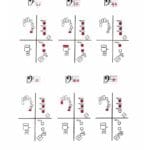This guide provides a comprehensive roadmap for navigating the baritone fingering chart, from beginner to advanced techniques. Whether you’re playing a euphonium, baritone saxophone, baritone guitar, or ukulele, you’ll find valuable information to enhance your playing.
Decoding the Baritone Fingering Chart
Understanding the baritone fingering chart is essential for any aspiring baritone player. It acts as a guide, showing which combinations of valves or finger positions produce specific notes. Having a readily available chart, whether printed or digital, is invaluable, especially when starting your musical journey. Resources like Stepwise Publications offer free printable charts and flashcards to aid in memorization. These charts typically organize valve combinations from open (no valves pressed) to 1-2-3 (all valves pressed), which helps with learning chromatic scales and understanding the instrument’s mechanics. However, not all charts explicitly label the notes, so choose one that does or supplement with flashcards. For a deeper dive into music theory and its practical applications, explore resources on biometria hematica.
Finding the Right Fingers for Your Baritone
Visual aids like fingering charts are your best friend when starting out. They provide a clear roadmap for your fingers, telling you exactly which keys to press to produce each note. For brass instruments like the euphonium, the chart organizes valve combinations based on the length of the tubing engaged. Open positions produce the instrument’s fundamental notes, while increasingly complex valve combinations access lower notes in the overtone series.
Perfecting Your Practice
Consistent practice is crucial for internalizing the fingerings and making them second nature. Even short, regular practice sessions help build muscle memory, leading to smoother and more effortless playing. Start with basic exercises like scales and simple melodies, gradually progressing to more complex pieces. This methodically strengthens your finger dexterity and improves your overall technique.
Compensating vs. Non-Compensating Baritones
Baritones come in two main varieties: compensating and non-compensating. The key difference lies in the fourth valve. Compensating baritones have a fourth valve designed to improve intonation across the entire range of the instrument, especially in the lower register. Non-compensating baritones, on the other hand, may require alternate fingerings for certain notes to maintain proper intonation. Knowing your baritone type is essential for selecting the correct fingering chart. If you’re looking to invest in a quality instrument or upgrade your current one, exploring options for a buretrol might be beneficial to enhance your musical experience.
Transposition for Saxophone Players
Saxophone players venturing into the baritone saxophone need to understand transposition. The baritone sax is a B♭ instrument, meaning the note it produces sounds a whole step lower than what’s written on the music. Using a fingering chart specifically designed for the baritone sax simplifies this process and eliminates the need for constant mental transposition.
Troubleshooting Common Issues
Even experienced players encounter occasional bumps in the road. Sticky valves can disrupt your playing, so regular maintenance is essential. Various exercises can improve finger dexterity and address issues like slow transitions between notes.
Exploring Advanced Techniques
Once you’ve mastered the basics, explore advanced techniques like alternate fingerings and unique valve combinations. These techniques add subtle nuances to your playing and expand your expressive possibilities. They’re not essential for beginners, but they significantly enrich your musical vocabulary as you progress.
Mastering the D on Baritone
The D is a foundational note on the baritone. Mastering it is crucial for building a solid foundation. The following sections detail how to play D on various baritone instruments.
Playing D on the Euphonium
- Fingering: No valves pressed (open). This is the simplest fingering on the euphonium.
- Embouchure: Maintain a relaxed, open embouchure – as if you’re about to say “oh.” Visualize blowing out a candle a few feet away – gentle, focused airflow.
- Practice: Use resources like YouTube videos for visual demonstrations of proper embouchure and fingering. Practicing D major scales reinforces the fingering and develops muscle memory.
Playing D on the Baritone Guitar
- Tuning: Baritone guitars are often tuned B-E-A-D-F♯-B. The open D string gives you an instant D note.
- D Major Chord Fingering: The D major chord on a baritone guitar uses the same shape as the G major chord on a standard guitar:
- Middle finger: 6th string, 3rd fret
- Index finger: 5th string, 2nd fret
- Pinky finger: 1st string, 3rd fret
- Optional: Ring finger on the 2nd string, 3rd fret (for a fuller sound).
- A Minor Chord Fingering: Use the D minor chord shape from standard guitar:
- Middle finger: 3rd string, 2nd fret
- Ring finger: 2nd string, 3rd fret
- Index finger: 1st string, 1st fret
Playing D on the Baritone Ukulele
- Tuning: The standard D-G-B-E tuning makes playing D incredibly simple. Just pluck the open D string.
- Fingerpicking: Explore fingerpicking patterns to add texture and complexity to your ukulele playing. Numerous online resources offer guidance.
- Chord Shapes: Practice chords incorporating D, such as D major, D minor, and G major.
Mastering the F-Sharp (F#) on Baritone
Playing F# on the baritone involves different approaches depending on the octave and the specific baritone instrument.
Playing F# on the Euphonium/Baritone Horn
- First Octave F#: Press the first valve down.
- Second Octave F#: Press the first and second valves down. Adjust your embouchure slightly – firm it up and increase airspeed.
- Overtone Series and Partials: Understanding the overtone series and how it relates to fingering and embouchure can significantly improve your intonation.
- Fourth Valve: On a compensating euphonium, the fourth valve can be used to improve the intonation of certain notes, potentially including F#. Experiment to find what works best.
- Troubleshooting: If your F# sounds unclear or out of tune, revisit your embouchure and airflow. Small adjustments can make a big difference.
Playing F# on the Baritone Saxophone
- Consult a saxophone fingering chart: F# fingerings on the saxophone can vary depending on the octave and whether you’re using standard or alternate fingerings. A reliable chart is essential.
- High F# Challenges: Reaching high F# on the saxophone can be challenging. Focused practice and embouchure adjustments are key to success.
Playing F# on the Baritone Ukulele
- F# Major Chord: While playing a single F# note may require specific techniques like bending, focusing on the F# major chord is more common in ukulele playing. Use online diagrams to learn the appropriate chord shape.
Mastering the A♭ (A-Flat) on Baritone
Playing A♭ on the baritone, particularly the euphonium, can be a bit tricky. Here’s a breakdown of the technique:
Playing A♭ on the Euphonium
- Fingering: The standard fingering for A♭ is 1st valve up, 2nd and 3rd valves down. Ensure each valve is fully pressed or released to avoid a muffled sound.
- Low A♭: Start by mastering the low A♭ using the same fingering as above. Focus on a controlled airstream and relaxed embouchure.
- High A♭: Use lip slurs to transition from the low A♭ to the higher A♭. Gradually tighten your embouchure and increase airspeed while maintaining the fingering.
- Embouchure and Airflow: Experiment with slight mouthpiece adjustments and breath support to optimize tone and control.
General Tips for All Baritone Instruments
- Practice Consistently: Regular practice is key to mastering any note on any instrument. Focus not just on hitting the note in isolation but also on smoothly transitioning to and from it within scales and melodies.
- Listen Actively: Listen critically to your playing and compare it to professional recordings. This helps you identify areas for improvement and develop a more refined ear.
- Warm-up: Always warm up before playing, especially before practicing challenging notes. This prevents fatigue and injury.
- Troubleshooting: Persistent issues may require expert guidance. Consulting a music teacher or experienced player can provide valuable insights and personalized advice.
By following this guide and dedicating yourself to consistent practice, you’ll be well on your way to mastering the baritone and unlocking its expressive potential. Remember, music is a journey, and every new note you learn is a step forward.
- Georgia Platform: A Southern Strategy, 1850s - March 31, 2025
- How many weeks is 40 days: Quick Conversion Guide for Accurate Results - March 31, 2025
- How many feet is 300 meters? 984 Feet: Understand Length Conversions Easily - March 31, 2025

















1 thought on “Baritone Fingering Chart: A Comprehensive Guide (Beginner to Pro)”
Comments are closed.